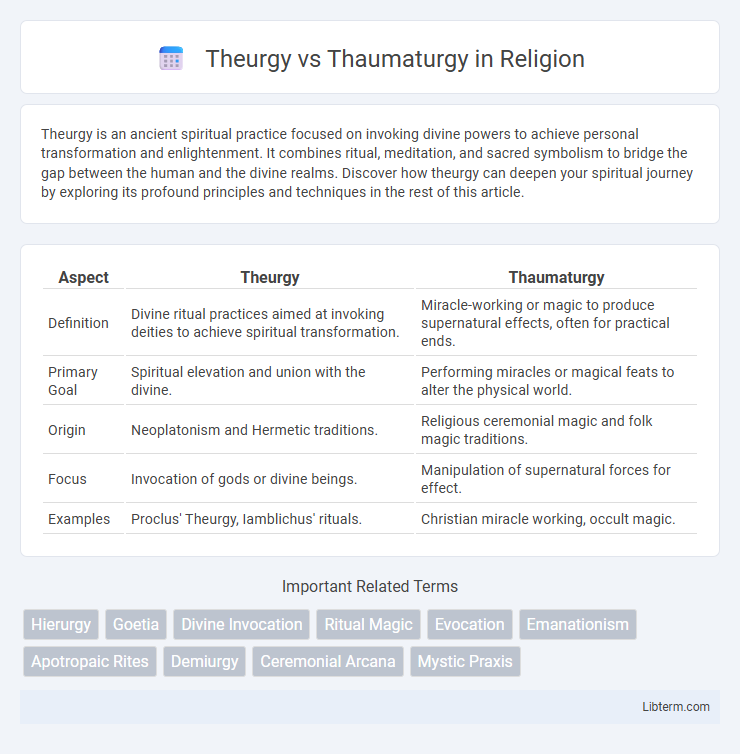Theurgy is an ancient spiritual practice focused on invoking divine powers to achieve personal transformation and enlightenment. It combines ritual, meditation, and sacred symbolism to bridge the gap between the human and the divine realms. Discover how theurgy can deepen your spiritual journey by exploring its profound principles and techniques in the rest of this article.
Table of Comparison
| Aspect | Theurgy | Thaumaturgy |
|---|---|---|
| Definition | Divine ritual practices aimed at invoking deities to achieve spiritual transformation. | Miracle-working or magic to produce supernatural effects, often for practical ends. |
| Primary Goal | Spiritual elevation and union with the divine. | Performing miracles or magical feats to alter the physical world. |
| Origin | Neoplatonism and Hermetic traditions. | Religious ceremonial magic and folk magic traditions. |
| Focus | Invocation of gods or divine beings. | Manipulation of supernatural forces for effect. |
| Examples | Proclus' Theurgy, Iamblichus' rituals. | Christian miracle working, occult magic. |
Understanding Theurgy: Definition and Origins
Theurgy, originating from ancient Greek philosophical traditions, is a spiritual practice aimed at invoking divine powers to achieve union with the divine or higher spiritual realms. Unlike thaumaturgy, which focuses on performing miracles or magical feats for practical effects, theurgy emphasizes inner transformation and enlightenment through rituals and invocations. Rooted in Neoplatonism, theurgy seeks to elevate the soul by harmonizing human and divine energies, fostering spiritual elevation rather than material changes.
Exploring Thaumaturgy: Meaning and Historical Roots
Thaumaturgy, derived from the Greek word "thaumaturgos" meaning "wonder-worker," refers to the performance of miracles or magic to invoke supernatural intervention. Historically, thaumaturgy has roots in religious and mystical traditions where practitioners sought to harness divine or magical powers to affect physical reality, such as in medieval Christian miracle-working or esoteric ceremonial magic. Unlike theurgy, which aims at spiritual transformation and union with the divine, thaumaturgy focuses on tangible, miraculous effects often linked to immediate worldly outcomes.
The Philosophical Foundations of Theurgy
Theurgy is rooted in Neoplatonic philosophy, emphasizing ritual practices aimed at uniting the soul with the divine through divine powers or gods, reflecting a spiritual and transformative process. It contrasts with thaumaturgy, which is primarily concerned with performing miracles or magic for practical or immediate effects without necessarily invoking deep spiritual elevation. The philosophical foundation of theurgy centers on achieving higher knowledge and divine illumination by harmonizing the microcosm (human) with the macrocosm (universe), reflecting a metaphysical quest for ultimate unity.
The Practical Applications of Thaumaturgy
Thaumaturgy primarily involves the practical application of magical techniques to produce immediate, tangible effects, such as healing, protection, or manipulation of natural elements. Unlike theurgy, which emphasizes spiritual enlightenment and divine communion, thaumaturgy serves functional purposes in everyday magical practices and ritualistic magic. Its effectiveness is often measured by observable results in influencing the physical or metaphysical environment.
Rituals and Practices: Theurgy vs Thaumaturgy
Theurgy involves complex rituals aimed at invoking divine beings to achieve spiritual transformation and union with the divine, often emphasizing meditation, prayer, and sacred symbolism. Thaumaturgy centers on performing miraculous acts or magic to influence the physical world, with rituals designed to produce tangible effects such as healing, protection, or elemental control. Both practices use specific rituals, but theurgy prioritizes spiritual elevation while thaumaturgy focuses on practical, supernatural outcomes.
Spiritual Goals: Transformation and Power
Theurgy aims at spiritual transformation by invoking divine powers to achieve union with higher spiritual entities, emphasizing internal enlightenment and sacred rituals. Thaumaturgy focuses on manifesting supernatural power to influence the physical world, often prioritizing practical outcomes like healing, protection, or miraculous effects. Both practices seek spiritual goals but differ with theurgy centered on transcendence and theurgy on tangible supernatural intervention.
Key Figures in Theurgical and Thaumaturgic Traditions
Key figures in theurgical traditions include Iamblichus, who systematized rituals invoking divine entities, and Proclus, known for integrating Platonic philosophy with esoteric practices; their work emphasized transformation through divine union. In thaumaturgic traditions, figures like John Dee and Aleister Crowley played pivotal roles by employing magic for tangible effects and personal empowerment, emphasizing practical manipulation of supernatural forces. These distinct lineages reflect theurgical goals of spiritual ascent versus thaumaturgic aims of magical efficacy.
Comparative Analysis: Mysticism versus Magic
Theurgy emphasizes spiritual transformation and divine invocation through ritual practices aimed at achieving unity with higher powers, while thaumaturgy focuses on producing supernatural effects or miracles often considered practical magic. Theurgy is rooted in mysticism, seeking inner enlightenment and metaphysical union, contrasting with thaumaturgy's goal of manipulating external forces for tangible outcomes. Understanding their distinctions highlights the contrast between sacred, transformative spirituality and pragmatic, ritualized magical actions.
The Impact on Western Esotericism
Theurgy, emphasizing divine invocation and spiritual transformation, has profoundly shaped Western esotericism by fostering a mystical path focused on union with higher powers. Thaumaturgy, centered on magical feats and practical miracles, influenced esoteric traditions by enhancing ritual techniques and symbolic practices. The interplay between these approaches enriched Western occult systems, integrating metaphysical spirituality with ritualized magical operations.
Modern Interpretations in Occultism
Modern interpretations of theurgy emphasize spiritual elevation and divine union, often associated with Neoplatonic and Hermetic traditions seeking to invoke higher powers for inner transformation. Thaumaturgy, in contemporary occultism, is understood as practical magic aimed at producing tangible effects or miracles in the material world, frequently linked to ceremonial magic and spellcasting. Theurgical practices prioritize metaphysical development through ritual invocation, while thaumaturgic methods focus on manipulating external realities using occult techniques.
Theurgy Infographic

 libterm.com
libterm.com